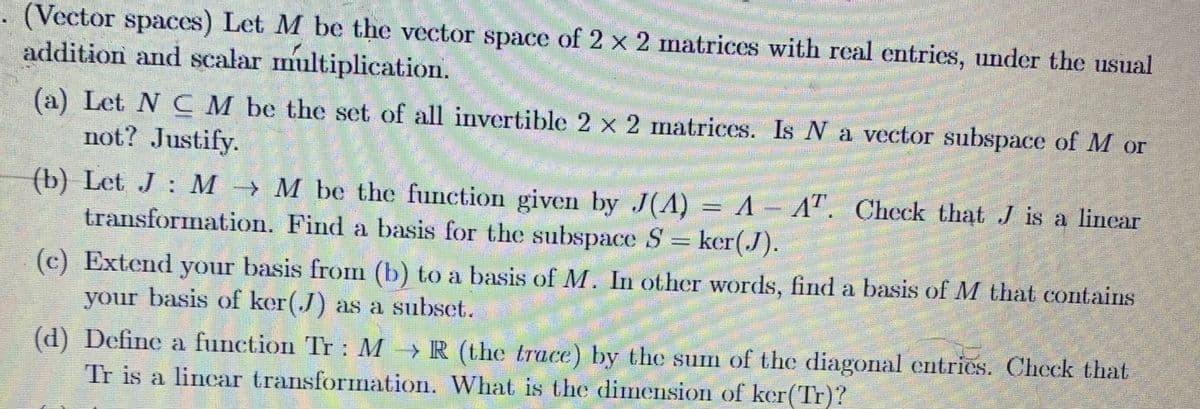Vector space of 2 x 2 matrices with real entries, under the usual tion and scalar multiplication. Let N C M be the set of all invertible 2 x 2 matrices. Is N a vector subspace of Mor not? Justify. Let J : M → M be the function given by J(A) = A - AT. Check that J is a lincar transformation. Find a basis for the subspace S = ker(J). Extend your basis from (b) to a basis of M. In other words, find a basis of M that contains your basis of ker(J) as a subset. Define a function Tr: M→ R (the trace) by the sum of the diagonal entries. Check that Tr is a linear transformation. What is the dimension of ker(Tr)?
Vector space of 2 x 2 matrices with real entries, under the usual tion and scalar multiplication. Let N C M be the set of all invertible 2 x 2 matrices. Is N a vector subspace of Mor not? Justify. Let J : M → M be the function given by J(A) = A - AT. Check that J is a lincar transformation. Find a basis for the subspace S = ker(J). Extend your basis from (b) to a basis of M. In other words, find a basis of M that contains your basis of ker(J) as a subset. Define a function Tr: M→ R (the trace) by the sum of the diagonal entries. Check that Tr is a linear transformation. What is the dimension of ker(Tr)?
Elementary Linear Algebra (MindTap Course List)
8th Edition
ISBN:9781305658004
Author:Ron Larson
Publisher:Ron Larson
Chapter5: Inner Product Spaces
Section5.CR: Review Exercises
Problem 41CR: Let B={(0,2,2),(1,0,2)} be a basis for a subspace of R3, and consider x=(1,4,2), a vector in the...
Related questions
Question
Part d please

Transcribed Image Text:(Vector spaces) Let M be the vector space of 2 x 2 matrices with real entries, under the usual
addition and scalar multiplication.
F
(a) Let N C M be the set of all invertible 2 x 2 matrices. Is N a vector subspace of M or
not? Justify.
HABERTA
J
(b) Let J: MM be the function given by J(A) = A - AT. Check that J is a lincar
transformation. Find a basis for the subspace S = ker(J).
(c) Extend your basis from (b) to a basis of M. In other words, find a basis of M that contains
your basis of ker(J) as a subset.
(d) Define a function Tr: MR (the trace) by the sum of the diagonal entrics. Check that
Tr is a linear transformation. What is the dimension of ker(Tr)?
Expert Solution
This question has been solved!
Explore an expertly crafted, step-by-step solution for a thorough understanding of key concepts.
Step by step
Solved in 3 steps with 2 images

Recommended textbooks for you

Elementary Linear Algebra (MindTap Course List)
Algebra
ISBN:
9781305658004
Author:
Ron Larson
Publisher:
Cengage Learning

Linear Algebra: A Modern Introduction
Algebra
ISBN:
9781285463247
Author:
David Poole
Publisher:
Cengage Learning

Elementary Linear Algebra (MindTap Course List)
Algebra
ISBN:
9781305658004
Author:
Ron Larson
Publisher:
Cengage Learning

Linear Algebra: A Modern Introduction
Algebra
ISBN:
9781285463247
Author:
David Poole
Publisher:
Cengage Learning